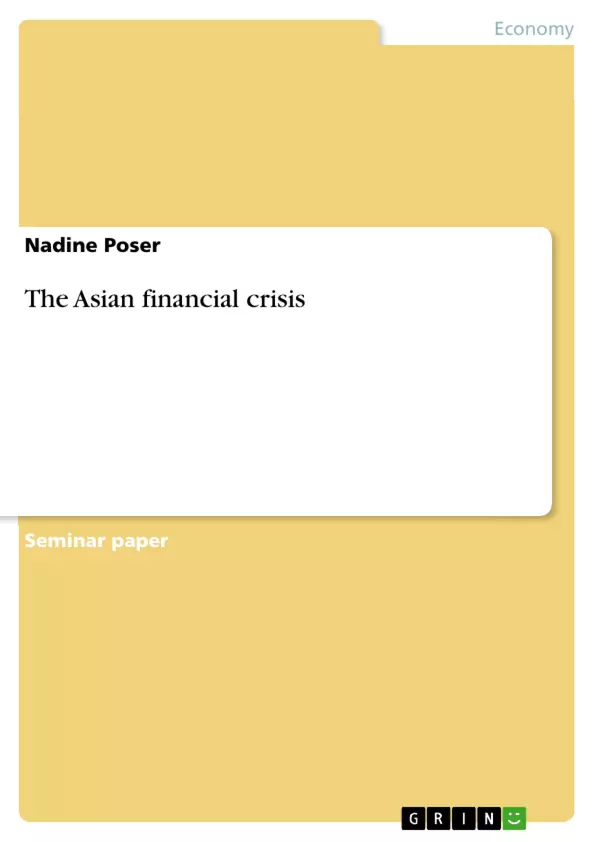After a period of economic upturn in the beginning of the 1990s, Asia has been concussed by a severe fiscal crisis in 1997. As the name implies the Asian Financial Crisis happened in Asia, more precisely in the Eastern Pacific Part of Asia (see Appendix A). Countries that have been affected most by the crisis are Indonesia, South Korea and Thailand. But also the Philippines, Malaysia, Laos and Hong Kong and even Australia had to deal with the unfavorable situation. Merriam-Webster Online Dictionary defines a crisis as “an unstable or crucial time or state of affairs in which a decisive change is impending; especially: one with the distinct possibility of a highly undesirable outcome” (2008).
The Asian-Pacific region counts to the leading tourism destinations in the world because of its rich biodiversity, beautiful beaches, cultural curiosities, a great interpretation of hospitality and nevertheless affordable prices. This report investigates the economic factors which led to the crisis. Further the impacts on the tourism industry are demonstrated and suggestions are made how the crisis probably could have been prevented combined with improvements for the future.
Inhaltsverzeichnis (Table of Contents)
- INTRODUCTION
- MAIN PARAGRAPH
- Factors that caused the Crisis
- Impact on Tourism
- Crisis Management
- CONCLUSION
- REFERENCES
Zielsetzung und Themenschwerpunkte (Objectives and Key Themes)
This report aims to investigate the economic factors that contributed to the Asian Financial Crisis of 1997, focusing on the impact on the tourism industry in the region. The report also explores potential strategies to mitigate future economic crises. Key themes explored in the report include:- The economic factors that led to the Asian Financial Crisis
- The impact of the crisis on the tourism industry in East Asian countries
- Strategies for crisis management and prevention
- The importance of sound monetary and fiscal policies
- The role of foreign debt in economic instability
Zusammenfassung der Kapitel (Chapter Summaries)
The report begins with an introduction, outlining the significance of tourism in East Asian economies and the impact of the Asian Financial Crisis on this vital sector. The report then explores the factors that contributed to the crisis, including the decoupling of the Thai Baht from the US Dollar, inadequate monetary and fiscal policies, corruption, and excessive foreign debt. The report also highlights the role of the banking system and the reliance of the private sector on foreign debt in exacerbating the crisis. The report then analyzes the impact of the crisis on the tourism industry, examining the decline in visitor arrivals and the economic consequences for countries like Thailand, South Korea, and Indonesia. The report also discusses the impact of the crisis on smaller nations like Lao PDR and Cambodia. The report concludes by exploring strategies for crisis management and prevention, emphasizing the importance of robust economic policies, responsible financial practices, and proactive measures to mitigate future economic shocks.Schlüsselwörter (Keywords)
This report focuses on the Asian Financial Crisis, examining the impact on tourism and exploring the contributing factors. Key terms include: economic crisis, tourism industry, East Asian economies, monetary policy, fiscal policy, foreign debt, corruption, crisis management, and prevention.- Quote paper
- Nadine Poser (Author), 2008, The Asian financial crisis, Munich, GRIN Verlag, https://www.grin.com/document/116675



